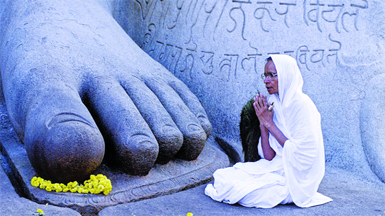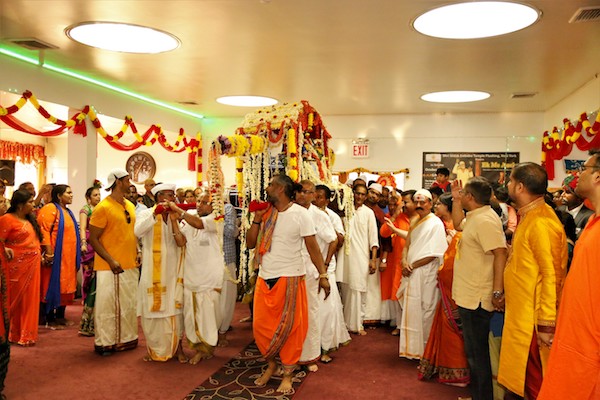
Though Mahavira or Mahavir was the founder of the historical Jainism, the jaina traditions maintained that there were 23 Tirthankars or prophets of that faith before the birth of Mahavira.
Mahavira thus is regarded as the twenty-fourth Tirthankara of the Jainas. It is said that the first of those prophets was Rishabha, and the last Tirthankara before Mahavira was Parsvanath.
The lives of the earlier Tirthankaras are unknown to history. Parsvanath, however, lived nearer to historical times and there-more, some accounts of him are available to history. But he, too, is said to have died 250 years before Mahavira, after living a full life of hundred years.
Parsvanath was the son of Asvasena, a Kshatriya king of Banaras. At the age of 30, he abandoned home in search of truth, and got his enlightenment after hard penance. He collected a large number of disciples to whom he preached his doctrines. The followers of his faith were asked to take four great vows, namely, to give up violence or injury to life, to be ever truthful, not to take property of others, and not to possess property of one’s own.
His successor to the faith, Mahavira, added the fifth vow, namely, to maintain celebacy, or Brahmacharya. Parsva believed in the eternity of all matter. Mahavira” also believed in that. This leads some historians to suggest that Parsvanath was the real founder of the Jaina faith. Mahavira Jina, however, gave that faith its real and historical form, and made it a great religion. He was the last Tirthankara or ‘the Ford-maker across the stream of existence’.
The original name of Mahavira was Vardhamana. He was born in a village named Kundagrama near the ancient city of Vaisali. His father Siddhartha was the chief of a Kshatriya clan, famous as Jnatrikas. His mother was princess Trishala, sister of the ruler of Vaisali, Chetaka. She was also related to some other royal families of that time. This shows that Vardhamana was born in a highly aristocratic family of fame and wealth.
The date of the birth of Vardhamana Mahavira is controversial. According to one calculation, he was born in 618 B.C. and died in 546 B.C. after a life of 72 years. According to another calculation, he was born in 540 B.C. and died in 468 B.C. Though some other dates are also suggested, the date of Mahavira’s death in 468 B.C. is accepted as a more probable date.
It is based on a tradition recorded by the famous Jaina monk Hemachandra that Chandragupta Maurya came to the throne after 155 years of Mahavira’s death. But, this calculation also creates difficulties when related to other historical events. The dates of Mahavira thus remain yet doubtful.
It is enough to know, that Mahavira belonged to sixth century B.C., was a contemporary of Buddha, and according to Buddhist sources, he died before Buddha. Vardhamana started his life like others. In his youth he married Yoshoda. A daughter was born to him. But the worldly attractions did not make him worldly-minded. At the age of 30, after the death of his parents, he renounced the world and became a monk.
He took to a life of extreme penance and a wandering monk. In search of truth he struggled for long twelve years. He subjected his body to all kinds of pain while moving from place to place. According to a description in a Jaina text: “He wandered naked and homeless. People struck him and mocked at him. Unconcerned, he continued in his meditations. In Ladha, the inhabitants persecuted him and set dogs on him.
They beat him with sticks and with their feet, and threw fruits, clods of earth and potsherds on him. They disturbed him in his meditations by all sorts of torments. But like a hero in the forefront of the battle, Mahavira withstood it all. Whether he was wounded or not, he never sought medical aid. He took no kind of medicaments; he never washed, did not bathe and never cleaned his teeth. In winter, he meditated in the shade; in the heat of the summer he seated himself in the scorching sun. Often he drank no water for months. Sometimes he took only every sixth, eighth, tenth or twelfth meal and pursued his meditations without craving”.
Such was the life of hardship that Vardhamana passed through. Finally, in the thirteenth year of his penance, he got enlightenment or the supreme knowledge or the Kevala Jnana. With that he became the Jaina or the Conqueror, Mahavira or the Great Hero and Kevalin or the All Knowing. After gaining the supreme knowledge Mahavira Jina preached his faith for long thirty years. He travelled far and wide and visited such places as Mithila, Sravasti, Champa, Vaisali and Rajagriha. Kings and commoners heard his doctrines with devotion. Among the rulers, kings Bimbisara and Ajatasatru paid him their respects.
It is known from the Jaina sources that he came as far as Kalinga and preached his doctrines from the Kumari Hill (the Udayagiri Hill near Bhubaneswar) to the people of Orissa. Everywhere, the common people as well as the kings listened to him. He was venerated as a great prophet. While wandering and preaching his gospels tirelessly, Mahavira Jaina died at the age of 72 at a place named Pava near the city of Rajagriha. His remarkable life was an example of austerity, purity and morality. To an India of spiritual hunger, Mahavira presented great doctrines to awaken men’s mind to a higher religious level.
Teachings of Mahavir
Tri-Ratna-Mahavira laid the greatest emphasis on a truly good life of the human beings. According to him, the three absolute conditions for good life were the Right Faith, the Right Knowledge, and the Right Action. These principles of life were described as the Tri-Ratna or the three jewels.
For such a good life, man was required to discover his own soul which was ‘The highest, the noblest and the fullest manifestation of all the powers’.
Mahavira did not bring God into his religious faith. While the universe was eternal, he did not find a creator behind it. Nor did he find the role of a creator to control and regulate the universe. According to him, all manifestations of power lay in the creation itself. The later Jainas came to believe that God might be just a ‘spiritual ideal’ which man could find in his own purified Atma.
When Mahavira did not give any importance to God, his religion kept no place for the priests to work between God and man. Thus came an opposition to the Brahminical supremacy in the spheres of religion. As the worship of Gods, offering of prayers, value of mantras, and the need of priestly class were denied, the Vedas and the Upanishads were also not given importance in the Jain thought.
Karma and Rebirth
In Jainism, the faith in the theory of karma and rebirth was absolute. Man has to work in order to live. His soul therefore, is engaged in various work. Mahavira gave the maximum stress on Karma. He divided all existing things into two categories, the living and the non-living. All the living beings were described as the Jivas. Each Jiva in the body was the Atma.
Since the Jiva existed in physical or material form, it got bound to action or Karma. Man was thus bound to exist with mental, verbal and physical activities. Naturally, therefore, his Atma became subject to his Karma. It was this Karma which decided the future of the Atma. If man did not do the correct Karma through his mind, speech and body, he was bound to suffer the results of his karma.
The Karma was thus the eternal law. Bad or good karma would go by bad or good results. And, there was no escape from it. Man was bound to suffer punishment for sins through birth and rebirth. The unending cycle of rebirth would continue as long as man did not perfect his thoughts, words and deeds to get released from rebirths.
Ahimsa
Absolute faith in Ahimsa or the non-violence received the highest place in Jainism. The life of every living being was regarded as sacred. The smallest of the small creatures also possessed life as did the human beings. It was therefore a supreme sin that man should destroy the life of other creatures. As man himself does not want to be injured or killed, so also no creature would like to be injured or killed. According to Jainism, it was the duty of man to protect and preserve the life of every living creature. To Mahavira Jaina, the practice of Ahimsa was like the highest duty of every man.
Reformism
Jainism rose as a new religion. Side by side, it challenged many existing evils of the Brahmanic faith. Mahavira Jaina was one of the greatest reformers of ancient India. He raised his voice against many social and religious systems of his time. In an age when religion mainly meant worship of many deities, practice of meaningless ceremonies, and sacrifice of animals, Jaina drew the attention of man towards higher spiritual goals. According to him, sins of life cannot be washed away by worship or prayers. Man can avoid sins by a virtuous conduct.
Jain Doctrines:
The jain canons may broadly be divided into two parts, the philosophical and the practical. The philosophical part contains ontology (a part of metaphysics dealing with the essence of things at the abstract level), metaphysics and psychology. The practical aspect relates to ethics and asceticism, monasticism and the life to be led by the laity.
Parsvanatha, who preached before Mahavira, had given four principles for a pure life. Those were, non-violence, truth, non-stealing, and non-possession. Mahavira Jaina added another principle namely Bramacharya or celibacy. According to him, these five qualities were necessary for leading a life towards perfection and to cross the stream of existence. Mahavira gave up all attachments towards wordly things. He even gave up the use of clothes.





Be the first to comment